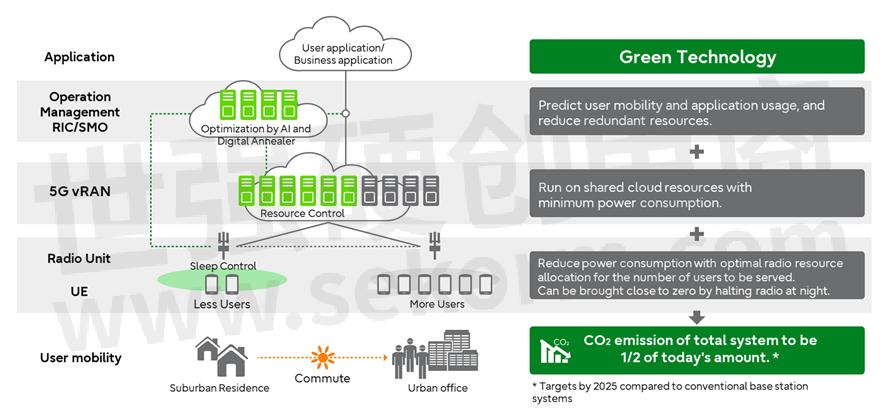Fujitsu Launches Sustainable 5G vRAN to Deliver Potential Reductions in CO2 Emissions of Over 50%

Fujitsu today announced that it has successfully developed new software virtualized radio access network (vRAN)(1) technology with support for 5G Standalone (SA) and will offer it for verification by telecommunications carriers from March 2022. By leveraging Fujitsu's AI and quantum-inspired “Digital Annealer”(2) technologies to optimize computing resources, the newly developed vRAN technology addresses one of the key challenges of conventional vRANs, delivering high-performance with low-energy consumption. Fujitsu estimates that this approach offers the potential to reduce overall system CO2 emissions by 50% or more compared to conventional base station systems by 2025, while offering users high-quality, stable communications.
Moving forward, Fujitsu plans to deploy this vRAN technology globally, offering robust and innovative support to telecommunications carriers working to reduce their carbon footprint, and ultimately contribute to the realization of a more sustainable society. Learn more about this at MWC Barcelona 2022 at Fujitsu’s Booth 2G60 from February 28, 2022 to March 3, 2022.

Background
In recent years, advances including performance improvements in general-purpose CPUs and the virtualization of wireless signal processing and control technology (telecom function) have opened an exciting wide range of new possibilities for technological innovation in communications, including the appearance of vRAN technology. The introduction of vRANs composed of general-purpose servers, which don’t require the costly development of specialized hardware, is currently drawing attention as an attractive alternative to conventional base stations.
Despite their promise, existing vRAN technology continues to face barriers to wider adoption. For instance, vRANs that are not configured with dedicated equipment tend to have lower performance efficiency than conventional base stations. To maintain the same performance, more hardware must be built in, resulting in higher environmental loads in areas like power consumption. In terms of stability and redundancy, there have also been cases in which conventional vRANs cannot sufficiently guarantee carrier-grade communication quality.
Features of Fujitsu’s vRAN
Fujitsu’s new vRAN technology supports 5G SA and conforms to O-RAN specifications, while leveraging the following proprietary technologies to successfully solve some of the challenges surrounding conventional vRANs. By optimizing the entire 5G wireless network and reducing the amount of equipment and power consumption, Fujitsu’s vRAN offers the potential to contribute to significant reductions in the total CO2 emissions throughout carriers’ 5G wireless systems.
1. Fujitsu's customization approach for high-performance, high-capacity communications
Improved software control methods for high performance and capacity in communications. Increase communication speed and communication coverage area from two to four times.
2. Dynamic resource allocation technology
Fujitsu has developed its own dynamic resource allocation technology that reduces excess resources and power consumption by making it possible to flexibly adjust the computing resources of servers needed for operations according to the usage status (traffic volume) of base stations, which varies with region and time of day. By linking the RAN intelligent control unit (RIC)(3), and SMO(4) which orchestrates and manages the entire network, with this technology, mobile phone users' movements and application usage are estimated and optimal resource allocation is achieved.
3. Automatic cell re-design technology
In addition to using AI to predict future traffic fluctuations, this system leverages Fujitsu's quantum-inspired Digital Annealer computing technology to enable optimal allocation of computing resources by rapidly solving problems that are difficult to solve with today's general-purpose computers. By using the superior combinatorial optimization capabilities of the Digital Annealer, it is possible to derive the optimal connection destinations from the various combinations of radio units (RU) and vRANs (Central Unit / Distributed Unit) in environments where radio waves from many base stations overlap.

CO2 emission reduction of the entire system using this vRAN
Future plans
In March 2022, Fujitsu will begin providing software that runs on general-purpose servers for carrier verification, and will support various types of verification, including field testing. By the end of fiscal 2022, Fujitsu plans to start offering this technology as a service on a global basis, with the aim of expanding it to the commercial service networks of each carrier. Its goal is to reduce total CO2 emissions by 50% or more by 2025, compared to conventional base station systems, by successively updating software functions and further improving technologies to reduce environmental impact.
- +1 Like
- Add to Favorites
Recommend
- What is the Difference between CPU and MCU?
- YINT‘s CPU and IO Interface Protection Solution
- Thermal Grizzly CPU Contact Frame Intel 1700 LT is Now Available
- Creating Autonomous I/O Systems without the Need for CPU Intervention
- Renesas Unveils the 1st Generation of Own 32-bit RISC-V CPU Core 32-bit Microcontrollers Ahead of Competition
- Renesas Pioneers RISC-V Technology With RZ/Five General-Purpose MPUs Based on 64-Bit RISC-V CPU Core
- Renesas RL78/G24 16-bit MCU Delivers Performance Comparable to 32-bit MCUs, with a FAA and CPU Operation up to 48MHz
- Nextron Has Ready Solutions for Intel’s New Generation Sapphire Rapids CPU of Eagle Stream Platform
This document is provided by Sekorm Platform for VIP exclusive service. The copyright is owned by Sekorm. Without authorization, any medias, websites or individual are not allowed to reprint. When authorizing the reprint, the link of www.sekorm.com must be indicated.





























































































































































































































































































































































































































































































































































































































































































































































































































































































